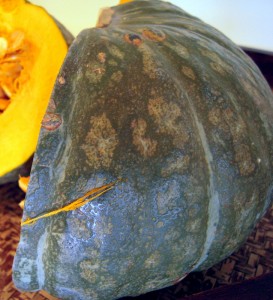kabocha interior: remove seeds and stringy bits
I absolutely love pumpkins, gourds and squashes of all types. In fact when we were thinking of a name for our site we thought about calling it cucurbita, which is the scientific name for this family of plants. Among all Winter squashes, kabocha pumpkin is my absolute favorite. It has a buttery and nutty flavor with a creamy texture and it’s naturally sweet. I ate a lot of these when I lived in Brazil but I didn’t see much of them in New York. In California they’re available all year round so you can enjoy them anytime. Not to be harsh, because they’re good too, but I like kabocha better than butternut squash. It just has more flavor. You should try it sometime.
Kabochas are round, perhaps shiny and dark green with whitish or yellowish streaks on the outer rind. They have a bumpy tough skin with bright orange-ish-yellowish flesh, like American pumpkins.

beautiful kabocha exterior
I prefer pumpkins and squash in savory dishes rather than in sweet, like’s popular here. In Brazil we never make pumpkin pies though we often cook them with salt and chile peppers. I should try making a pie out of kabocha next time I visit my relatives, just to see what they would think of it.
When I was a teen I briefly took Japanese classes. It was fun to hear the sound of western words adapted to the Japanese language. As I recall for instance, the English expression, “traveler’s check” becomes something like toraberazu checku in Japanese. The famous Japanese expression of thanks, arigato, derives from the Portuguese word with the same meaning, “obrigado.” There are others.
My sensei (teacher) would sometimes end the class by offering us some cold soba noodle soup along with wedges of steamed cooled kabocha rinds. The snack was served at room temperature which was very refreshing in the tropics. What he did not tell us was that “kabocha” itself is another word borrowed by the Japanese from the Portuguese! Perhaps he did not know? After all the Portuguese had visited them about 5 centuries ago, so much has passed since then, right?
Japanese kabocha pumpkin like all other squashes are from the new world; from Meso- America, actually, which is the chunk of land south of Mexico and north of South America. Presumably kabocha was taken to Asia by the Portuguese. Ah, those brave Portuguese! Just to imagine them on those fragile caravels crossing the oceans makes me sea-sick already!
cutting kabocha
First kabocha traveled to Cambodia and then from there to Japan. The word for pumpkin or squash in Portuguese is abóbora. By the time this gourd was introduced to Japan, the name had already changed a bit. In Cambodia, it was called Cambodia Abóbora.The Japanese simplified this long-ish name Kabocha. This was based upon the sound of the word for this exotically foreign vegetable. Eventually, it migrated back to the Americas but the Japanese name stuck: kabocha.
There tons of things you can make from kabocha. Today I made it in risotto. I hope that you like it.
Japanese Kabocha Pumpkin Risotto
Ingredients:
1 & 1/3 cup arborio rice
1 & 2/3 cup kabocha, peeled with inner seeds and strings removed, cut into medium sized cubes
1/3 cup fresh onion, chopped fine
1 clove garlic, minced
1/3 cup Parmigiano-Reggiano, grated cheese
¾ cup dry white wine
5 to 6 cup vegetable broth or water
1/3 cup fresh flat leaf Italian parsley, chopped
2 tsp Spanish capers in brine
kosher salt to taste
freshly ground black pepper
How to:
Using a deep pan sauté onion for a few minutes till translucent. Add garlic and sauté for another minute or so. Add kabocha and sauté for few more minutes. Add white wine and cook pumpkin continuously stirring for 3-4 minutes. Add Arborio rice and half of the remaining water or vegetable broth. Reduce temperature to medium to have a brisk simmer. Keep stirring. Add more broth when necessary. Stir it up! The process will take about 20 minutes and the rice will be a little soupy. It is done when rice reaches the al dente consistency, so you’ve got to test it towards the end for doneness. Add salt to taste. Remove from heat then add cheese, parsley, capers, black pepper. Let it rest for about 5 minutes and voilá!
finished squash risotto
The finished risotto has a vibrant color and the flavors are divine! Serve with white wine. We had it with this cheap and delicious pinot grigio frizzante from Italia bought at our local TJ’s store! Cheers.
Comments on this entry are closed.
I love both food and language history, so that was really interesting to me. I also like risotto and squash. Your dish looks yummy! I found this website from a comment on The Economist’s site.
Julia
Thanks for your really kind comments. We’re pretty proud of this site ourselves. Glad that you enjoy it! Can’t wait to hear how the risotto turns out when you make it yourself 😉
Your site is cool, too. Great to know that there are other vegetarian bloggers out there. Too bad about the hot peppers though. We love spice here though it doesn’t always match well with red wine!
OMG that risotto is gorgeous! I definitely want to make this. I see pumpkin in the store and (admittedly) associate it with a certain time of year. I’ve got to get out of that thinking. Besides, orange foods are so good for you (saw it on Dr. Oz!). Lovely!